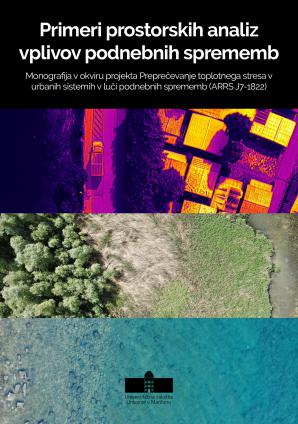Primeri prostorskih analiz vplivov podnebnih sprememb: Monografija v okviru projekta Preprečevanje toplotnega stresa v urbanih sistemih v luči podnebnih sprememb (ARRS J7-1822)
Keywords:
spatial analysis, climate change, geographic information systems, spatial patterns, environmental crisisSynopsis
Case Studies of Climate Change Effects Spatial Analysis: A monograph Based on Findings from the Project Preventing Heat Stress in Urban Systems Under Climate Change (ARRS J7-1822). In the period of digital transformation of society, information technologies are gaining in importance. This includes geographic information systems that link location data to all types of descriptive information, thus providing a basis for mapping and spatial analysis. The latter is used today in both science and industry. With the help of this type of analysis, it is easier to understand past and present spatial patterns that are the result of the interaction of natural and social conditions. Based on the recognized trends, we can then estimate what the further spatial development will be. The ability to predict objectively is one of the key features that further increases the usefulness of spatial analysis in terms of evaluating the consequences of climate or environmental crisis. This fact is the reason for the creation of the monograph entitled Case Studies of Climate Change Effects Spatial Analysis. The publication is divided into three chapters. The first deals with urban environments and addresses the issue of increasing heat stress as a consequence of the emergence of urban heat island effect (UHI) and a warmer atmosphere due to (anthropogenically driven) climate change. The second chapter deals with the effects of climate change on selected habitats of the cultural landscape, whether in intensive or extensive agricultural use. In the third chapter, the content shifts from terrestrial to costal and marine environments.
Downloads

Downloads
- Sezonski režim površinskega mestnega toplotnega otoka v Mariboru Sezonski režim površinskega mestnega toplotnega otoka v Mariboru
- Vpliv podnebnih sprememb na gnezdenje obrežnih ptic Vpliv podnebnih sprememb na gnezdenje obrežnih ptic
- Modeliranje podnebne ustreznosti za gojenje oljk (Olea europaea) na vzhodnem Jadranu (Slovenija, Hrvaška) Modeliranje podnebne ustreznosti za gojenje oljk (Olea europaea) na vzhodnem Jadranu (Slovenija, Hrvaška)
- Vpliv urbanih zelenih površin na pojav mestnega toplotnega otoka Vpliv urbanih zelenih površin na pojav mestnega toplotnega otoka
- Krčenje morskih travnikov v slovenskem morju zaradi vpliva podnebnih sprememb in drugih posrednih dejavnikov Krčenje morskih travnikov v slovenskem morju zaradi vpliva podnebnih sprememb in drugih posrednih dejavnikov
- Interakcija naravnih in družbenih razmer kot pospeševalec zaraščanja Krasa Interakcija naravnih in družbenih razmer kot pospeševalec zaraščanja Krasa
- Spremenljivost dolžine rastne sezone in termalnega časa v Mariboru v obdobju 1971-2020 Spremenljivost dolžine rastne sezone in termalnega časa v Mariboru v obdobju 1971-2020






